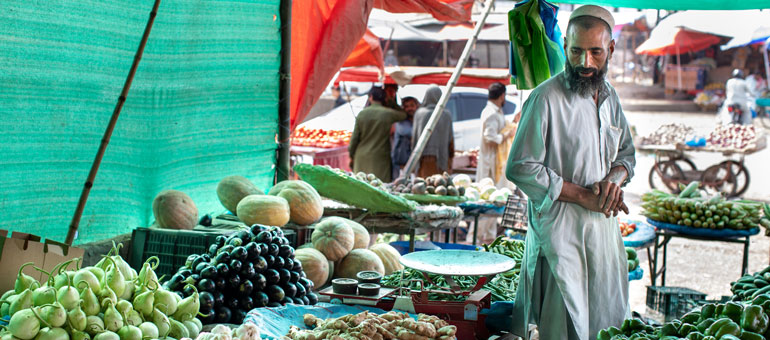Last year on this blog, I announced the GAIN Business Model Research (BMR) Project: funded by the Netherlands Ministry of Foreign Affairs, this project aims to identify promising business models to reach consumers on lower incomes with nutritious foods. Such approaches could help to improve the quality of diets—which currently are often lacking in food diversity and quality—if they can provide food that meets customers’ needs at an affordable price. But they must do so in ways that are profitable and sustainable for the company. How can they do this?
To find out, the BMR project undertook a systematic review of existing research and evidence. We screened about 8,000 documents before selecting 74 documents, and 99 case-study companies, that were eligible for inclusion. We included companies producing highly nutritious foods as well as those producing less nutritious alternatives—with the understanding that they might offer insights that could be applied to nutritious foods. We then analysed these documents to extract and synthesise 13 specific approaches used by firms to reach lower-income consumers with food and beverage products. Here, we discuss two of these approaches.
Repurpose waste—for environmental and nutrition benefit
Food loss and waste is a major problem worldwide: it is estimated that 14% of all food produced globally is lost between harvest and retail, while 17% is wasted. For the most nutrient-dense foods, which tend to be highly perishable, levels are even higher, exceeding 20% for the category of fruits and vegetables. By taking food that would otherwise be wasted and repurposing it into something than can be consumed (or can be an input into something that can be consumed), firms may be able to create a more affordable product, given that the ‘waste’ food ingredient is usually available cheaply or for free. And this business model feature comes with the added benefit of reducing the environmental impact of the local food system.
Two of the reviewed companies (Reybanpac in Ecuador and Happy Cow in Kenya) used whey, a high-quality easily digestible protein left over from processing milk into cheese, to create a fortified yoghurt. In both contexts, whey was previously disposed of as waste – in Ecuador, dumped into rivers at a rate of 800,000 litres a day – and thus could be acquired cheaply (or for free through the companies’ own processing of cheese). In Ecuador, the product in question was UHT processed (thus shelf-stable), low-sugar, and targeted to lower-income young children as a complementary food. In Kenya, the product could be sold for up to 40% cheaper than comparable yoghurts without whey. Both were sold in small packages to increase affordability. (GAIN is currently working in Pakistan to co-develop such approaches with local dairy companies).

Food loss and waste is a major problem worldwide: it is estimated that 14% of all food produced globally is lost between harvest and retail, while 17% is wasted. © GAIN
Limpho Productos Alimentares in Mozambique uses broken nuts that would not normally be sold to make nut butter and is aiming to use a similar approach to create rice flour-based products from broken rice. Finally, Kwanza Tukule, a Kenyan company that produces and delivers pre-cooked beans for street vendors, also has an interesting take on repurposing waste: they use food scraps from their vendor-clients to feed a biogas digester; the biogas is then used to cook the beans, resulting in lower energy costs as well as greener energy. Seed cakes (the residue left over from extracting oil from seeds) and crop residues are other examples of waste products with potential for use in nutritious foods.
Use less-desired parts – at lower costs
An alternative to using waste products is recognising that some parts of a product, while not quite waste, are less desirable to most consumers; these can be separated from the rest of the product and sold separately at a lower cost. This can be done for products that would normally be sold as a whole (e.g., chicken) or for which only desirable parts would be sold and the other products diverted to waste or non-food uses.
For example, a tilapia farmer in Mozambique separates the fillet from the offal and carcass of the fish and sells the latter parts at a low price (cost plus 5%), while making most of their money from the high-end fillet. Multiple chicken farmers in Mozambique and Kenya do similarly, selling the chicken offal and other offcuts like skin, neck, and feet at a cheap price while selling the more desirable chicken meat (e.g., breasts, fillets, drumsticks) at market prices to wealthier consumers. One of the companies in Mozambique, for example, sells a package of chicken neck, liver, and legs for less than half the per-unit price of a whole chicken. A goat farmer in Mozambique, MozAgri, likewise sells the main goat meat to urban markets at market prices while selling the ‘fifth quarter’ (i.e., pieces of an animal carcass that are not used for meat production, like organs, hide, intestines, feet, the head, horns, hooves, bones, and/or fat) to the local rural population around the farm at affordable prices.
Of note, this is a business model feature that has long been used by traditional butchers and fishmongers. However, the firms mentioned above have integrated the process into a more ‘modern’ business model (e.g., with improved hygiene, packaging, and/or marketing)—potentially improving quality and safety, expanding scale, or increasing appeal to a wider set of consumers.
Both these approaches are, at their core, about identifying value that might otherwise go unrecognised, valorising it, and presenting it to the customer in an appealing format to meet their needs – and boost nutrition along the way.